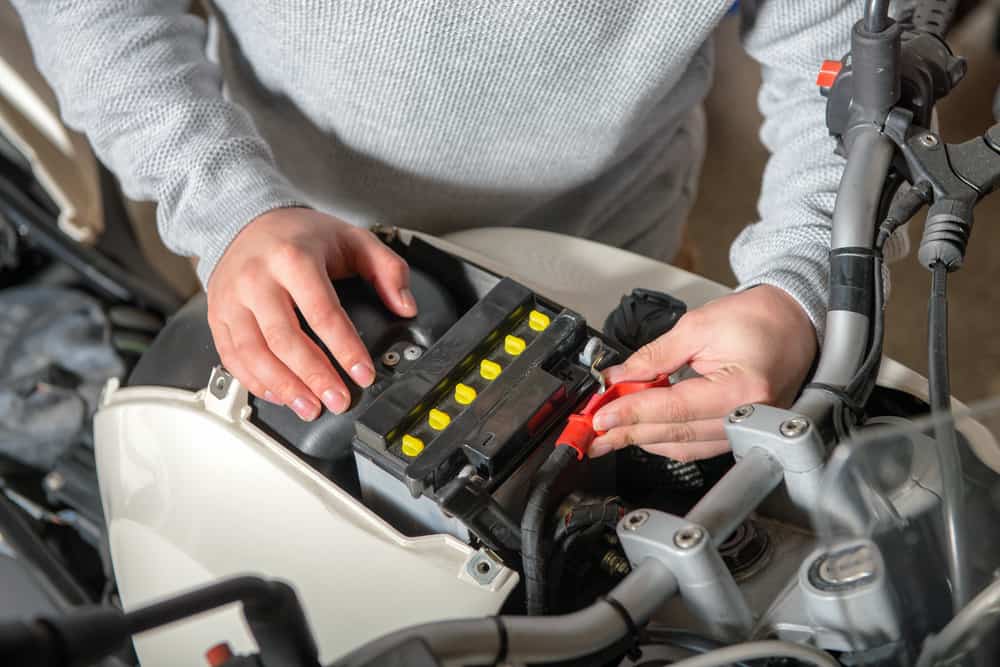There’s a lot of confusion among motorcyclists about whether a motorcycle battery is 6 volts or 12 volts. The truth is – it is neither.
Your motorcycle’s battery chemistry is a lot more complex than you think. In this post, we’re going to simplify things for you.
We’ll find a definite answer to how many volts is a motorcycle battery and understand the performance-determining technicalities of a motorcycle battery in simplest terms.
Let’s get started!
Table of Contents
How many volts is a motorcycle battery?
Nowadays, most motorcycle batteries are 12 volts on the spec sheet. However, in reality, the batteries are about 12.6 volts.
That’s because each motorcycle battery comprises six individual cells. Each cell has a charge of 2.1 volts. Hence:
6 x 2.1 = 12.6 volts
Older motorcycles feature 6-volt batteries. Again, 6 volts is only a measure for the spec sheets. In actuality, the battery has three individual cells, each with a charge of 2.1 volts. They add up to the following:
3 x 2.1 = 6.3 volts
The reason older motorcycles had a lower battery voltage is that they did not have electric starters. An electric starter is a DC direct current motor that integrates with wiring within the motorcycle and allows you to start the engine by pressing a small button only.
A vintage motorcycle did not offer advanced electrical systems like these. And hence, it operated on smaller voltages.
So, to sum up, how many volts is a motorcycle battery?
Here’s a short answer:
- Motorcycles manufactured after the 1960s have a charge of 12.6 volts.
- Motorcycles manufactured before the 1960s have a charge of 6.3 volts.
How does a motorcycle battery work?

Quite interestingly, the voltages of a motorcycle’s battery may rise or drop from its standard value (i.e.12.6V). Here’s what the extremes of a bike’s energy range could look like:
- Maximum voltage rise: 13.5 volts
- Maximum voltage drop: 10.5 volts
The operating voltage depends on the charge status of the battery, load, and maintenance.
We’ll explore more on how to maintain the optimum voltage. But before we get to that, let’s understand why this fluctuation occurs.
Mechanism of a Battery
A motorcycle battery is a lead-acid battery, which can be of three types. These include:
- Wet Cell Battery: These batteries use lead-antimony. They are cheap and have a short life.
- Gel Battery: Gel batteries comprise electrolytes. They are relatively maintenance-free but are more usually expensive. Plus, overcharging may cause irreversible damage to the electrolyte within the battery.
- AGM Battery: AGM is short for Absorbed Glass Mat. These batteries are more efficient, capable, long-lasting, and of course, expensive.
Generally, these three types of motorcycle batteries have a similar structure and working mechanism. Each 12V battery of a motorcycle battery pack has about six cells, and each cell has positively and negatively charged lead plates.
The plates are alternately arranged and the higher the number of plates, the greater current & capacity of the battery. The battery cells with plates are connected by linking spark plugs with the right terminals. And internally, the battery is filled with battery acid, i.e. electrolyte.
The electrolyte is a solution of sulfuric acid and distilled water. It reacts with the lead plates to form lead sulfate, converting battery acid into water.
As a result, electrons are released. They flow from the negative terminal of the battery to the engine (hence, forming current) and return to the battery via the positive terminal.
As the battery discharges, the electrolyte becomes dilute. When the maximum discharging level is reached, the chemical process reverses and the battery begins to charge.
Suggested: Explore the electrolysis of a lead-acid battery
Given the working mechanism of a battery, the voltage levels drop because of the following reasons:
- Bad terminal connection
- Corroded terminals
- Faulty components (like stator, regulator)
- Excessive load (such as additional accessories like LED lights)
If you continue to use your motorcycle with any one of these conditions being true, there’s a high chance the battery will deteriorate quickly. And thus, it will drop voltage and lose efficiency.
We encourage exploring all of these factors in greater detail over here. Voltages may also drop in newer batteries if the connecting cable vibrates loose.
With that said, voltage rise is a consequence of low internal resistance. Usually, voltage rise is not something you should worry about. It indicates that the battery is healthy and fully charged.
How to check the voltage of a motorcycle battery?

Technically, there are two ways you can know the volts of a motorcycle battery. These include:
- Reading its manufacturer-provided spec sheet
- Measuring the voltage across its terminals using a multimeter or a voltmeter
When it comes to reading, the number mentioned on the battery casing comprises two digits. The first digit represents nominal or average voltage, while the second digit represents the CCA (cold cranking amps). The CCA is always smaller than the average voltage.
But if you wish to measure the volts in a motorcycle battery accurately, you will need a multimeter/voltmeter to get started.
- First, take your safety precautions. Lead-acid batteries are highly flammable. So, you need to work in a well-ventilated area and put away anything that can cause a spark. It is also a good idea to wear gloves and goggles.
- Next, locate the battery on your motorcycle. It’s usually underneath the seat and you might need to elevate the seat to reach the battery.
- Once located, clean the terminals. It might have debris or corrosion accumulated over it. You can use a battery-cleaning solution or baking soda with water to clean it up.
- Now, connect voltmeter probes with battery terminals. Connect the red one with the positive terminal and the black one with the negative terminal. Ensure that you connect the positive terminals before you connect the negative terminals.
Following the connection, you’ll see a voltage reading on the multimeter or voltmeter screen.
Here are the possible voltage readings you can observe and their corresponding meanings:
| Voltage | Meaning |
| 12.9 volts | Overcharged battery (unhealthy) |
| 12.6 – 12.8 volts | Fully-charged battery (healthy) |
| 12.4 volts | Battery requires recharge |
| 12.2 volts | The battery requires recharging via a trickle charger. |
| 11 volts | The engine has been running for a while. |
| 9.5 volts | The battery is damaged and needs replacement. |
How to properly maintain motorcycle batteries?
How can you avoid your battery’s voltage from rising too high or dropping too low?
You can avoid damaging fluctuations and ensure normal charging voltages by maintaining your bike battery in the following ways:
- Inspect the battery biweekly and clean the terminals.
- Ensure the wiring and cables within the battery are not lost.
- Top the battery with distilled water whenever you feel like there’s a need.
- Check for battery leaks and fix them if you find any
- Wash your bike regularly and keep its battery fully charged
- Charge your motorcycle battery properly
Also, if you notice something wrong with the battery, replace it immediately!
FAQs

1. Are motorcycle batteries universal?
No. Generally, there are about 3-4 groups of motorcycle batteries. These groups further divide by means of cold-cranking amps as well as physical size. You should buy the type of battery that’s recommended by the manufacturer.
2. How many volts is a Harley Davidson motorcycle battery?
All modern-day motorcycle batteries are 12 volts. Be it Harley Davidson Sportster XLH or a Yamaha YFZ model.
3. How long does a motorcycle battery last?
On average, a motorcycle’s battery lasts for 2-5 years. It can last much longer if you use the battery properly.
4. Does a motorcycle battery charge while running?
Yes! Similar to cars, motorcycle batteries can charge while running. There’s an alternator fitted well with a regulator, which ensures that the battery charges while running.
5. Do motorcycles use lithium-ion batteries?
Yes. Some newer models of motorcycle use lithium-ion batteries. However, owing to the expensive pricing, it’s not a popular option.
6. What is self-discharge in lead acid batteries?
Lead-acid batteries discharge by themselves even when they are not in use. This is because of the electrochemical processes going on inside of them.
Usually, the self-discharge rate for most lead-acid batteries is about one percent. But a motorcycle can lose 50 percent of its charge if you don’t ride it for two weeks or so.
End Note
All in all, 12 volts is the simplest answer to the question: how many volts are in a motorcycle battery? But it’s not all-embracing.
A motorcycle’s battery may hold 9.5 volts or 12.9 volts depending on its usage, charge status, connected load, and efficiency of electrical systems within. Browse the guide above to find out what is affecting your motorcycle battery and how you can maintain it. If there are any questions, let us know in the comments below!
